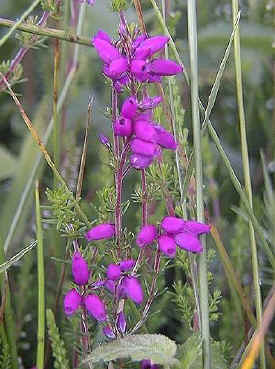Heathland Project Report
Introduction List of Summary Points Summary
Flora left: Bell Heather on the Heathland Restoration site. left: Bell Heather on the Heathland Restoration site.A total of 90 species have been recorded on the heathland site over the three year period from 1996 - 1998 (Species list). Grasses and sedges can be extremely difficult to identify accurately to species level, particularly if no flowers are present. The initial survey in 1996 identified Agrostis grasses and many of the sedges only to genus level. Complete species numbers are therefore unavailable for 1996. In the most recent survey in 1998, seventy nine species were recorded. However, most of these species are fairly rare. Several different measures can be used to assess species abundance, depending both on the type of community being surveyed and on the level of data collected during the survey. Percentage frequency and percentage cover are both measures of abundance. Percentage frequency is a measure of how often a species occurs in samples. For example, if a species is found in every quadrat sampled, then it has a % frequency of 100%. If it is found in 10 out of a hundred samples, then it would have a % frequency of 10%. Percentage frequency therefore tells us how common a species is, but it does not give information on how much of the species is present once we have recorded it. Percentage cover is an additional measure of abundance which tells us how much space a species occupies in a sample, once its presence has been noted. These two measures are obviously related (the more space a species occupies, the more likely it is to be found in more than one sample), but using the two together can give information on how species are distributed in a habitat. For example, if a species was found to have a low % frequency, but a relatively high mean % cover, it would indicate that the species was occurring (rarely) but in large clumps where it did occur. this would suggest that the species had a very clustered distribution. Equally, a species might have a very high % frequency, showing that it was widespread over the habitat, combined with a low mean % cover, which would tell us that while it was common, it was not very dominant in the habitat in terms of % cover. Using these measures of abundance, we can conclude that most of the species found on the project site in 1998 were not common. Seventy one of the 79 species recorded in 1998 had a percentage frequency of less than 25% (i.e. were found in less than a quarter of all quadrats sampled). Only 8 species had a mean % cover of more than 5% over the whole site, and most had a mean % cover of substantially less than 5%. |
Continue to heather distribution on the restoration site
| Heathland Restoration Project Report | ||||
Other Lowland Heaths in East Devon
